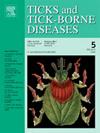逆行杂交与IDEXX SNAP 4Dx®检测特立尼达犬无形体病/埃利希体病的比较
IF 3.4
2区 医学
Q2 INFECTIOUS DISEASES
引用次数: 0
摘要
众所周知,犬埃利希体和鸭无原体是特立尼达最常见的蜱传犬血病原体,它们是由吸血鼻头蜱的蜱虫物种复合体传播的。在特立尼达,通常根据临床症状、实验室检查和对治疗的反应来诊断这些病原体。然而,由于这些病原体在血液涂片的显微镜检查中往往没有观察到,因此有必要采用其他方法来提供明确的诊断。特立尼达的兽医经常使用IDEXX SNAP 4Dx®测试来确定犬类患者的暴露状况,并决定是否应该对其进行治疗。本研究对从231只狗身上获得的样本进行了IDEXX SNAP 4Dx®检测和聚合酶链反应(PCR)以及反向行杂交(RLB)检测,以确定这两种检测之间是否存在可接受的一致性水平。该研究显示IDEXX SNAP 4Dx®测试与RLB之间的一致性较差。本文章由计算机程序翻译,如有差异,请以英文原文为准。
A comparison of reverse line blot hybridization and IDEXX SNAP 4Dx® test in detecting canine anaplasmosis/ehrlichiosis in Trinidad
Ehrlichia canis and Anaplasma platys are known to be among the most common tick-borne hemopathogens of dogs in Trinidad that are transmitted by ixodid ticks of the Rhipicephalus sanguineus sensu lato species complex. These pathogens are commonly diagnosed in Trinidad based on clinical signs, laboratory tests and response to treatment. However, as these hemopathogens are often not observed on microscopic examination of blood smears, alternative methods to provide a definitive diagnosis are warranted. The IDEXX SNAP 4Dx® test is used frequently by veterinarians in Trinidad to determine exposure status and inform decisions on whether a canine patient should be treated. This study investigated the use of the IDEXX SNAP 4Dx® test and polymerase chain reaction (PCR) followed by a reverse line blot hybridization (RLB) assay on samples obtained from 231 dogs in order to determine if there was an acceptable level of agreement between the two tests. The study showed poor agreement between the IDEXX SNAP 4Dx® test and RLB.
求助全文
通过发布文献求助,成功后即可免费获取论文全文。
去求助
来源期刊

Ticks and Tick-borne Diseases
INFECTIOUS DISEASES-MICROBIOLOGY
CiteScore
6.90
自引率
12.50%
发文量
185
审稿时长
6-12 weeks
期刊介绍:
Ticks and Tick-borne Diseases is an international, peer-reviewed scientific journal. It publishes original research papers, short communications, state-of-the-art mini-reviews, letters to the editor, clinical-case studies, announcements of pertinent international meetings, and editorials.
The journal covers a broad spectrum and brings together various disciplines, for example, zoology, microbiology, molecular biology, genetics, mathematical modelling, veterinary and human medicine. Multidisciplinary approaches and the use of conventional and novel methods/methodologies (in the field and in the laboratory) are crucial for deeper understanding of the natural processes and human behaviour/activities that result in human or animal diseases and in economic effects of ticks and tick-borne pathogens. Such understanding is essential for management of tick populations and tick-borne diseases in an effective and environmentally acceptable manner.
 求助内容:
求助内容: 应助结果提醒方式:
应助结果提醒方式:


